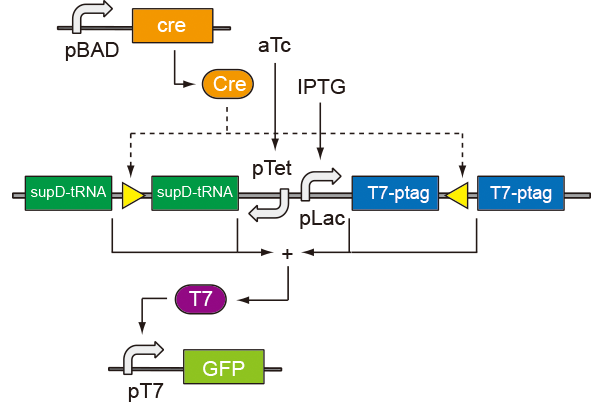Team:Tsinghua-A/Wetlab/Part1
From 2012.igem.org
(Difference between revisions)
| Line 41: | Line 41: | ||
<p style="margin-left:300px;"><b>After Reverse</b></p> | <p style="margin-left:300px;"><b>After Reverse</b></p> | ||
| - | <table border="1" | + | <table border="1" > |
<col width="100"> | <col width="100"> | ||
<col width="100"> | <col width="100"> | ||
| Line 95: | Line 95: | ||
</br></br> | </br></br> | ||
<p style="margin-left:300px;"><b>Before Reverse</b></p> | <p style="margin-left:300px;"><b>Before Reverse</b></p> | ||
| - | <table border="1" | + | <table border="1" > |
<col width="100"> | <col width="100"> | ||
<col width="100"> | <col width="100"> | ||
Revision as of 17:59, 26 September 2012

Tsinghua-A::Wetlab::Prokaryotic cells

Construction in Prokaryotic cells
In prokaryotic cells, the system consists of three circuits. One induces flip, one flips and the other expresses. According to the properties of the promoter pBAD, we build the first circuit, using arabinose as an inducement to generate the recombinase Cre. After the content of Cre increasing, loxP sites flip, causing the expression of supD tRNA and T7ptag. T7ptag and supD tRNA act as an AND gate which can active T7 promoter by (iGEM 2009 PKU_Beijing.) Details and truth tables are as follows.

Before Reverse

After Reverse
| IPTG | aTc | TT-ptag | supD-tRNA | GFP |
|---|---|---|---|---|
| 0 | 0 | 0 | 0 | 0 |
| 1 | 0 | 1 | 0 | 0 |
| 0 | 1 | 0 | 1 | 0 |
| 1 | 1 | 1 | 1 | 1 |
Before Reverse
| IPTG | aTc | TT-ptag | supD-tRNA | GFP |
|---|---|---|---|---|
| 0 | 0 | 0 | 0 | 0 |
| 1 | 0 | 1 | 1 | 1 |
| 0 | 1 | 1 | 1 | 1 |
| 1 | 1 | 1 | 1 | 1 |
After Reverse
 "
"